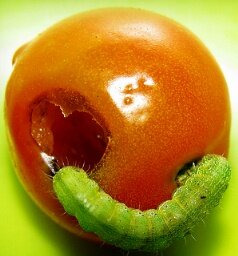Growing Tomatoes
Tomatoes are the MOST popular of all vegetables! Once you know how to grow tomatoes, it's easy to get huge, tasty yields.

Growing tomatoes is not confined to certain conditions either. Well it is, but luckily they are very tolerant little darlings and it's up to YOU to create the perfect home for them.
This is possible whether you live in a hot or cold climate, live upstairs in an attic or at the top of the world in an igloo — okay, pelt me with rotten tomatoes, I'm wrong... it's NOT possible to grow tomatoes in an igloo.

BUT you get the idea; with a bit of fiddle fuddling around, anyone, anywhere — mostly, can grow luscious tomatoes.
Botanically tomatoes are fruits... but somehow tomatoes with chocolate ice-cream for dessert... no thanks.
Originally called pomme d'amour or love apple by the French, we still adore tomatoes even though those aphrodisiac qualities from several hundred years ago have been disputed.
So whether you say tomayto and I say tomarto or pomme d'amour; here's how to grow tomatoes. . . .
What are the best tomatoes to grow?
To begin with, all tomato plants are classified as determinate or indeterminate.
Determinate varieties are small bushy plants that don't need staking, grow to a certain size and produce one crop only. Determinate tomatoes are excellent to grow in containers or confined gardens.
Indeterminate tomatoes grow on long vines and need staking. They keep producing tomatoes until cold or frost stops them. Most heirloom varieties—grown for their flavour, are indeterminate.
With indeterminate tomatoes, any laterals (side shoots) that grow off the main stem and leader branches should be pinched out, as plants will not produce large abundant fruit if they are allowed to grow multiple shoots here there and everywhere.
Carefully choose tomato varieties to suit your climate. Some famous cold climate tomatoes are 'Oregon Spring.' and 'Siberian Red.' And for warmer and more humid climates, it's best to check what others are growing locally.
Also with humid areas, it's wise to choose varieties that have been proven to resist fungal diseases.
Planting Tomatoes
About 6 weeks before you want to plant out your tomato seedlings, you can sow seeds. Best temperatures are between 24°C daytime to 16°C night for good germination.
Transplant seedlings into garden or bigger pots once the first true leaves are formed above the small seed leaves. When planting in the garden, bury the stem, either upright or on its side, right up to the main leaves. Helpful roots will grow underground from the stem.
Plant in a sunny, well drained, sheltered spot, in good compost which is slightly acid (pH5.5 to 6.8). It will take roughly 3 months until you can really start decent pickings.
Seedlings should be 60cm apart, and if in rows, allow nearly 100cm between rows. This allows for good air flow and reduced moisture on leaves to combat fungal and blight problems and fruit decay.
Staking and Supporting Tomato Plants
One good stake for the main stem and a stake for each of the 2 to 4 leaders are needed. A cage, netting or fence can be used to attach the stems, but the main thing to remember is to keep the branches off the ground to stop rot and to support the branches, as they can break easily.
Use strips of cotton or stockings, or soft yarn and tie tightly around the wire or stake and looped loosely around stem just below a leaf node.
Caring for Tomato Plants

Pests and Diseases: Check each day if possible and remove caterpillars. Cover with netting if birds like your tomatoes. Remove leaves and spray with an organic fungal spray if any signs or blight, mildew or rot.
Mulch: Mulching is important for tomatoes. It stops soil-borne diseases from splashing onto the leaves, it keeps warmth in and roots at a more even temperature, retains moisture and control weeds.
Feeding: A good rule is to feed your plant fortnightly when in full growth, then once fruit has started to form (this is called fruit setting), increase to weekly feeds. A liquid fertilizer both on leaves and roots is excellent.
Water: Setting up an irrigation drip system is ideal before you plant, but otherwise water every few days or daily in hot weather. Watering is best done in the morning and around the roots. It should be even and regular otherwise blossom-end rot, sclerotiorum and stem rots can occur. Sometimes even with the most careful of gardeners, a rainy downfall can happen and this can make the tomatoes swell and skins split.
Pruning: Remove all leaves and shoots below the first main leader branches. You don't want soil or water splashing up.
If you live in an area with hot, scorching sun, leave most leaves on to prevent sun-scald on the fruits, otherwise remove any particularly large or damaged leaves throughout the plants to allow light and air to get a look in.
To establish robust plants with strong stems and roots and good leaf growth, it helps to remove the first flowers so the plants don't devote energy to forming fruit instead. Wait for plants to get to around 30cm tall before allowing fruits to set.
Harvesting: Near the end of summer, around a month or so before any frosts or cold spells, it's time to stop your tomato plants growing and fruiting.
Start by cutting off their heads, then any new growth on their stems. Be careful not to snip off any tomatoes that might become fat and juicy in next few weeks or months. Finally when the first shivery winds begin to blow, stop watering, which stresses the plants and tells them it's time to ripen fruits asap.
You can also remove lots of leaves now to let as much warmth as possible hit the fruits. Any unripe and green fruits can be picked and put in a cooler, dark place, on a dry surface such as material, netting or paper and left to ripen. Do have a stickybeak most days to check for ripeness or disease.

NOTE: If you're like me, growing tomatoes brings out a gleam in a veggie gardener's eye.
When can I pick my first tomato...how long can I make the tomato season last?
Magic questions, and with expert help, see below, you can have a long, trouble-free, tomato growing season.
Although I've been growing tomatoes half my life and I thought I knew it all... I'm in love with this 'tomato bible' HOW TO GROW SUPERB TOMATOES. I can't praise it enough, and I believe it's by far the best way to learn how to grow tomatoes 100% successfully.
There were 100+1 mistakes I made when I first started seriously to grow decent tomato crops. There is so much good and bad, in fact really bad advice out there, that it can be frustrating and wasteful to wade through it all.
I've done the wading, and I know I could never hope to match this book for its depth of superb, easy to follow information. This is my recommendation for this product, and where to buy from. I'd love you to click the link HERE and read more to see if you can benefit too.
I get a steady string of testimonials for this book... I enjoy hearing readers' success stories; and if you purchase through this link, you'll help support this site so I can do more reviews on gardening products.
Tomatoes go well with all vegetables, so what else would you like to grow? Have a look here List of Vegetables





